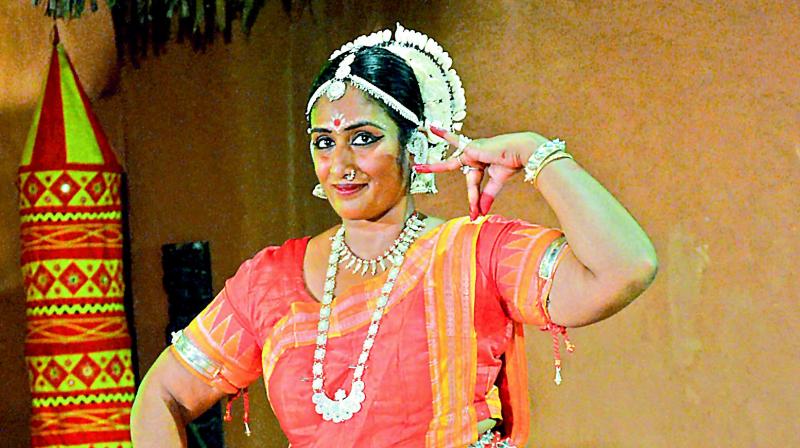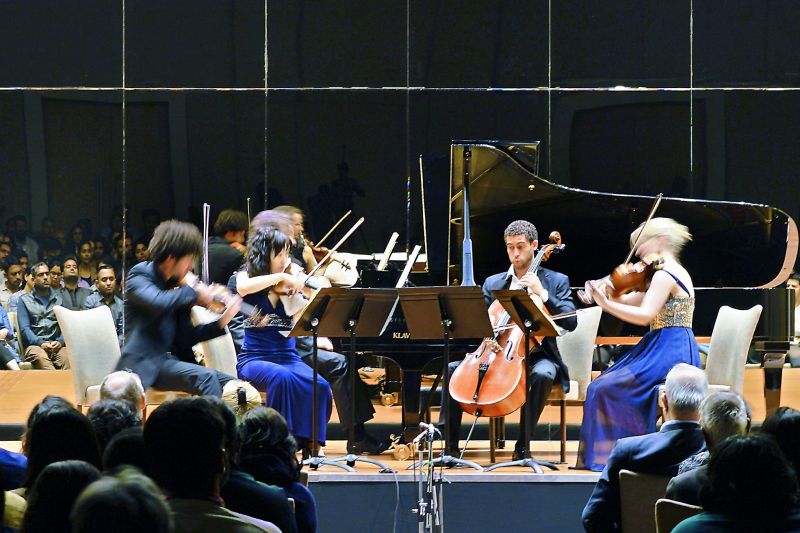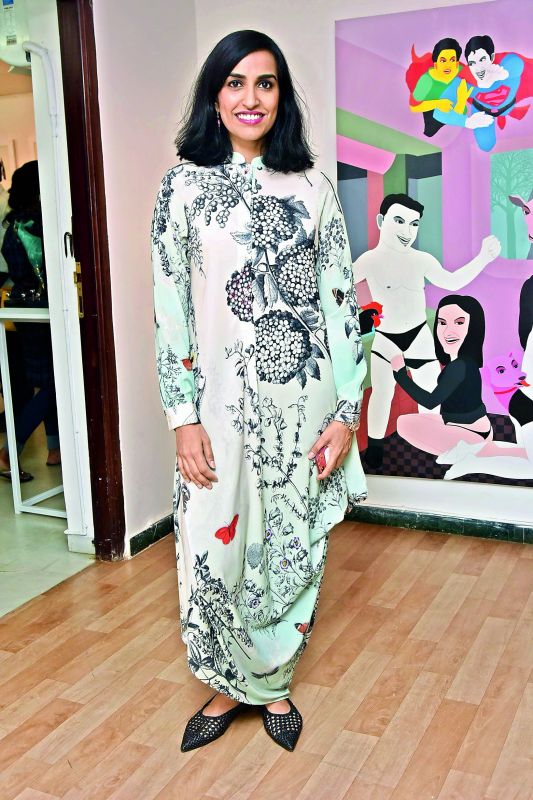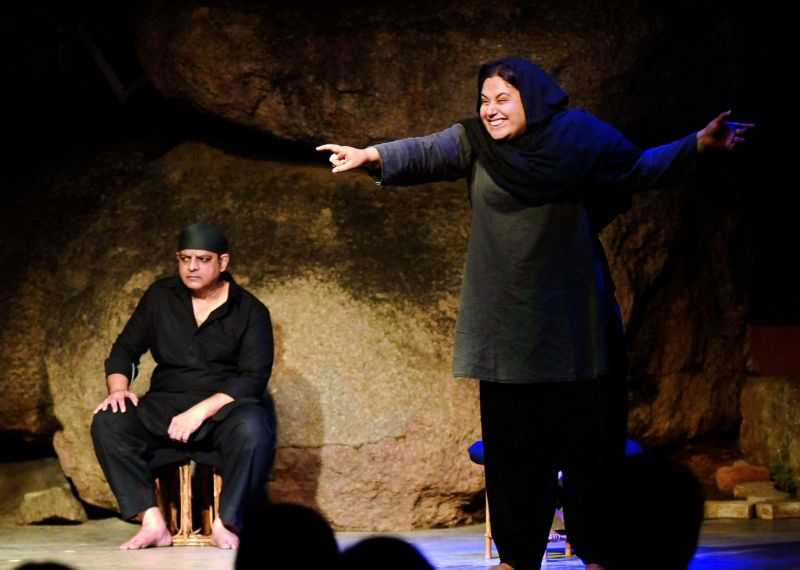Hyderabad's tryst with art and culture

A city’s inherent identity emerges from the fabric of its industry, enterprise, language, literature and culture. In the last decade, there has been a significant change in the artistic and cultural ethos of Hyderabad. Be it art and literature festivals with nationally and internationally renowned artists, authors and photographers showing their work or readings; or a range of theatre, dance and music performances practised by a range of artistes from classical to avant garde. Hyderabad is now on par with, or in some case, better than, Mumbai, Chennai, Bengaluru and Kolkata in its cultural character.
Like most metros, Hyderabad now has an annual roster of big ticket events. In the recent past, a significant number of individuals have carved out space actual real estate and resources infrastructure to serve their community and are bridging a gap in the cultural milieu. To which, the people of Hyderabad have responded with enthusiasm.
Both Goethe Zentrum (GZ) and Alliance Francaise (AF) have been the centre for foreign language films, music, literature, art and photography as mandated by their governments. Goethe Zentrum actively takes part in many festivals.
Mini Naini, the Cultural Communication Coordinator at AF, says that the rise of culture in Hyderabad is such that, “We are spoilt for choice! Every day there is something or the other happening in Hyderabad, It has become so culturally vibrant!”
Cultural Spaces
As free cultural spaces go, the first and most significant was Lamakaan. The liberal space was so innovative and novel that it immediately became popular and turned the tide of commercial interests. “It’s been eight years since we started and there is still a huge demand for the space. I think the draw may be, that it still continues to be an independent space, it is independent even from us,” says Ashhar Farhan, one of the founders. Lamakaan is popularly credited with almost single-handedly revitalising theatre in Hyderabad. “The few state-run cultural venues were high rental and low occupancy that were unavailable to upcoming or unknown artistes. There was a need for proactive and interactive art and performance spaces that were available to all,” says Subbareddy Adapala, the curator for Phoenix Arena, a cultural venue since early 2017 in Madhapur.
 Saptaparni come into existence was because Anuradha Reddy, the director, wanted to provide a venue for classical vocal performances. Anuradha gave up a piece of real estate to set up the space
Saptaparni come into existence was because Anuradha Reddy, the director, wanted to provide a venue for classical vocal performances. Anuradha gave up a piece of real estate to set up the space
Our Sacred Space in Secunderabad, started in 2012, was an initiative by Nayantara Nanda Kumar who converted an ancestral home into an art centre. An Odissi dancer and an environmental engineer, Nayantara’s aim was, “to provide a community space, an open space for environmental work, classical and folk art, wellness and inner work”. Since its inception, Our Sacred Space has become a regular haunt for talks, workshops and regular classes that span an array of creative pursuits. Nayantara says, “There is such a wonderfully wide range of culture that is thriving in the city right now.” The Guruswamy Centre is the newest liberal performance space to come up, “My family has been in this city for the last 100 years and I thought it was time to give something back. And in the scope of the Tricity, I felt Secunderabad was being left behind,” says Mohan Guruswamy, founder and President of Centre for Policy Alternatives. The Guruswamy Centre, which went live in October of 2018, is situated at the valuable real estate on S.D. Road, on the fourth floor of a ANZ Plaza, a development by Guruswamy’s family. “The space is a donation to the city. I have not set an agenda for the space. I am waiting to see what will emerge from whatever people need when they come here,” he says. According to Sunitha Sharma, the manager, the primary reason for Saptaparni to come into existence was because Anuradha Reddy, the director, wanted to provide a venue for classical vocal performances.
A Carnatic music aficionado, she wanted a suitable space that will allow for music to thrive. So she gave up a piece of valuable real estate to the people of Hyderabad and set up the amphitheatre, auditorium and children’s book shop as Saptaparni. The Apollo Amphitheatre which was started in December of 2017, and is a green, lush space that encourages healing through arts as a part of the wholistic health Apollo Life agenda. According to the Sujata Sengupta, the cultural manager and events curator, medical drugs are not the only curative therapy that Apollo offers. The space is becoming a unique cultural hub.
Food For Thought Manthan
While cultural spaces have fostered and encouraged cultural language and ethos in the city, some initiatives have been powered by intent and an idea that has propelled a cultural movement. Manthan is the brainchild of Ajay Gandhi and Vikram Mamidipudi, who cofounded this cultural concept back in 2005, based on, “Our conviction that good, intelligent conversation, high quality discourse are essential for a healthy society,” says Ajay. “The news on TV and the media rhetoric is not aligned with our thoughts or beliefs, so we decided to just have gatherings and invite leaders from a slew of fields, influencers of public opinion to speak at a public forum,” he adds. “Our line-up of speakers have had such an impact on our understanding of politics, economics, judicial process, international relationships, the constitution.
 Ajay Gandhi one of brains behind Manthan
Ajay Gandhi one of brains behind Manthan
The list goes on.” Manthan has hosted 260 conversations so far and each has been, “the best that we can do”, he adds. Originally, the aim was to invite prominent speakers who were visiting Hyderabad but lately, we invite people to attend these conversations. “Over the years more and more speakers have come back again and again to participate in Manthan conversations,” says Ajay; Y.V. Reddy, Arun Shourie, Bezawada Wilson, P.M. Krishna, Ravi Bhtalingam, Dushant Dave, Ravish Kumar, Shashi Tharoor, Kanhaya Kumar, Arun Shourie… to name just a few. The aim of the organisation was to be accessible to everyone so no five star hotels as venues.
Western Classical Music
State of The Art (SOTA)
Timothy Marthand and Shruti Kurien started SOTA in January of 2018 as a means of de-tainting Western classical music of its “otherness”, “I want to give it a fresh start, with no associations with the past. Like cricket; it no longer is defined as a game form the west. It is just cricket,” says Timothy, a concert pianist who has travelled all over the world to hone his craft, including training for five years at the International Piano Foundation, Lake Como Italy.

SOTA, in its very short existence has organised eight performances of Western (sic) classic concerts and is set to roll out six more in January 2019. The response to their initiative has been surprising, “The tide is turning and people in Hyderabad have realised that there is more to life and are hungry for something meaningful.” Although still very new, Timothy has big plans for SOTA and Hyderabad, “I want Hyderabad to have its own symphony orchestra of its own. It will be the first orchestra of it’s kind in India.”
Revivals Gudi Sambaralu
In 2015, Shashikala Reddy and Sri Nagi Rao started an unlikely little movement called Gudi Sambaralu (temple festivities) to bring back the practice of temples being the centres of social and culture activity. “Temples used to be the traditional gathering place for villages and communities. And we with Gudi Sambaralu, have chosen the temples as venues with no religious overtones to add a certain soulful overtones to the performances,” says Sri Nagi. In the three years of its existence, Gudi Sambaralu has had theatre (including Pathalabhairavi and a wonderful interpretation of Mahabharat with five dance forms), dance and literary recitals in places like Bapatla, Gadwal, Mahbubnagar and other parts of Andhra Pradesh and Telangana state. And since the performances are open to all, the locals, who would otherwise not have had access to the range of national and international artistes, have been deeply appreciative. “Now when we host an event, we have people crowding to it.
 Sri Nagi and Shashikala
Sri Nagi and Shashikala
And leaders of many communities are inviting us to the temples in their region to conduct our programmes. It has been a phenomenal response from everyone,” says Sri Nagi. “Suddenly these temples in and around the city have now become fashionable venues for weddings and other ceremonies,” adds Shashikala. Which means the patronage is making the temples self-sustaining. “Culture nurtures the spirit of people and when they appreciate an art form, it becomes a part of everyday life,” says Shashikala. Although, this is a private enterprise, “Apart from ourselves, the funds are raised mainly from our friends and family,” says Sri Nagi.
Art and Photography
Muse Art Gallery, Dhi Art Space, Icon Art Gallery, Pegasus Art Gallery, Alankritha Art Gallery, Gallery Space, Kalakriti Art Gallery, Shrishti Art Gallery and State Art Gallery
Art was first to emerge at the beginning of the cultural awareness curve in Hyderabad. The city already boasted of significant names on the national and international scene like Laxma Goud, Surya Prakash, Thota Vaikuntam, Laxman Aelay and Rajeshwar Rao, Kavita Deusekar etc… and art galleries became a venue for cultural conversations in the city. The State Art Gallery recently hosted an Indian Photography Festival and had featured exhibitions, artists talks, panel discussions and more. And galleries like Kalakriti and Shrishti have been pivotal to discourse about art and its appreciation in the city. “We have spaces to showcase a wide range of artists from the masters to newcomers. We believe in encouraging upcoming artists with our many initiatives like scholarships, residencies and exchange programmes that we undertake with different countries,” says Rekha Lahoti, of Kalakriti Art Gallery.
 Lakshmi Nambiar of Shrishti Art Gallery
Lakshmi Nambiar of Shrishti Art Gallery
But it is no longer a single focus for them although art is the main driver, Kalakriti also undertakes heritage walks, symposia, performances, talks with authors, film screenings and school out-reach programmes. The 2019 Kalakriti Art and Culture Festival will be its 16th edition. And once again presents a cornucopia of cultural events that leave you stimulated. “In this hyper consumerist world with its disposable culture there can be a disconnect with oneself and the realities around one. Art has a way of bringing it all back to the personal space to the self,” says Lakshmi Nambiar of Shrishti Art Gallery, who took over from her mother. Galleries in the city make space to engage and encourage upcoming artists and provide them with a platform.
Theatre
Samahaara, Sutradhar, Nishumbita, Udaan, Sifar, Bhoomika and Dramanon
In Hyderabad, theatre has had a bit of a start and stop journey. While we’ve had ongoing theatre groups like Torn Curtains, Little Theatre and Rangadhara apart from a vibrant Marathi and Telugu theatre scene, they had limited reach. Since the emergence of free cultural spaces many smaller groups, often breakaways of the older traditional school of thought, have come up.
 A still from a play staged by Sutradhar
A still from a play staged by Sutradhar
Groups like Samahaara, Sutradhar, Nishumbita, Udaan, Sifar, Bhoomika and Dramanon predominantly showcase direct adaptations of Western, Russian and North Indian plays. The heartening thing is that original playwrights are also coming to the fore, like Soumya and Sushma Nittala, who wrote plays like Five Women and a Bill and the latest, Side Track. Theatre in all its variations amateur, interpretational, adapatations and original are finding their audience in the city.

